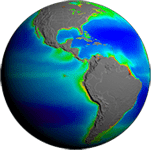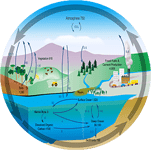Heating Up (and Down) the Ocean Food Web
Marine heatwaves impact ocean life from whales to phytoplankton
PACE's data will help us better understand how the ocean and atmosphere exchange carbon dioxide. In addition, it will reveal how aerosols might fuel phytoplankton growth in the surface ocean. Novel uses of PACE data will benefit our economy and society. For example, it will help identify the extent and duration of harmful algal blooms. PACE will extend and expand NASA's long-term observations of our living planet. By doing so, it will take Earth's pulse in new ways for decades to come.






Our ocean teems with life and many of its most vital species are invisible to us. Like on land, the ocean has deserts, forests, meadows, and jungles, providing habitats for many forms of life. The types of life in these habitats is determined by microscopic algae that float in our ocean. Known as "phytoplankton," these tiny organisms come in many different shapes, sizes, and colors. The diversity of phytoplankton types determines the roles they play in ocean habitats. It also determines how well they capture energy from the sun and carbon from the atmosphere.
Read MoreSmall particles suspended in the atmosphere are known as aerosols. Along with clouds, they affect how sunlight is reflected and absorbed by the Earth and its atmosphere. Aerosols and clouds can interact in complex ways, which are not well understood. For example, cloud drops can form on aerosols and aerosols can be washed out of the air by rain. The overall effect of aerosols and clouds on climate is quite uncertain.
Read MoreCarbon exists in forms that range from invisible gases to diamonds. Most life on earth is composed of carbon, as well. In the ocean, a system of physical and biological processes drives the transition between forms of carbon. This system supports life and regulates our planet's livable environment. A key process in the carbon system is photosynthesis and its key players are phytoplankton. These tiny plants and algae convert carbon dioxide gas into organic matter. This organic matter, in turn, supplies food and energy to most life forms in the food web.
Read MoreThe PACE mission will provide a combination of global atmospheric and oceanic observations to benefit society in the areas of water resources, impact of disasters, ecological forecasting, human health, and air quality.
PACE Applications will partner with public and private organizations on ways to apply data from PACE and its scientific findings in their decision-making activities and services, helping to improve the quality of life and strengthen the economy.
The U.S. ocean economy contributes over $350B to the GDP (2014) and supports more than 3.1 million jobs (one in 45). Currently, this ocean economy, including the Great Lakes, is growing faster than the total U.S. economy in both contributions to inflation-adjusted GDP (15.6% since 2007 compared to 5.8%) and jobs (8.1% compared to flat).
PACE will be the first mission to provide measurements that enable prediction of the boom-bust of fisheries, the appearance of harmful algae, and other factors that affect commercial and recreational industries.
Phytoplankton provide food for small zooplankton, tiny animals that float in our ocean. Like humans, these grazers actively select their food. In the same way, larger zooplankton prey upon smaller zooplankton. Step by step, energy captured from phytoplankton transfers to bigger creatures. As the energy climbs the marine food web, it can ultimately be used by humans.
The ocean is a fluid that is constantly in motion. Hosting the largest three-dimensional living space on earth, it supports many habitats. For example, the North Atlantic is home to highly productive "forests" each spring. Its blooms of carbon-rich phytoplankton fuel the fisheries of New England. The crystal-clear waters around Florida host productive coral reefs and fisheries. At times, however, this area is plagued by toxic phytoplankton.
Today's satellites reveal the quantity of phytoplankton at the ocean surface. Yet we cannot detect the diversity of species. For the first time, PACE's unprecedented technology will:
On February 8, 2024, NASA’s PACE satellite roared into space aboard a SpaceX Falcon 9 rocket. Less than two months later, NASA engineer Joseph ...
Read MoreIn the early 2000s, a team of scientists at NASA’s Goddard Space Flight Center in Greenbelt, Maryland, prototyped the Ocean Radiometer for ...
Read MoreThe PACE mission has delivered its first operational data back to researchers, a feat made possible in part by innovative, data-storing technology ...
Read MoreNASA is now publicly distributing science-quality data from PACE, providing first-of-their-kind measurements of ocean health, air quality, ...
Read MoreMarine heatwaves impact ocean life from whales to phytoplankton
Expanding our understanding of Earth's climate
Take a global tour of PACE's Ocean Color Instrument (OCI) images!
PACE can help improve forecasts… no matter where you live
PACE is designed to ID phytoplankton communities from space
Sensational synergies between NASA missions
These “small grapes” can cause big problems
How PACE aligns with this effort